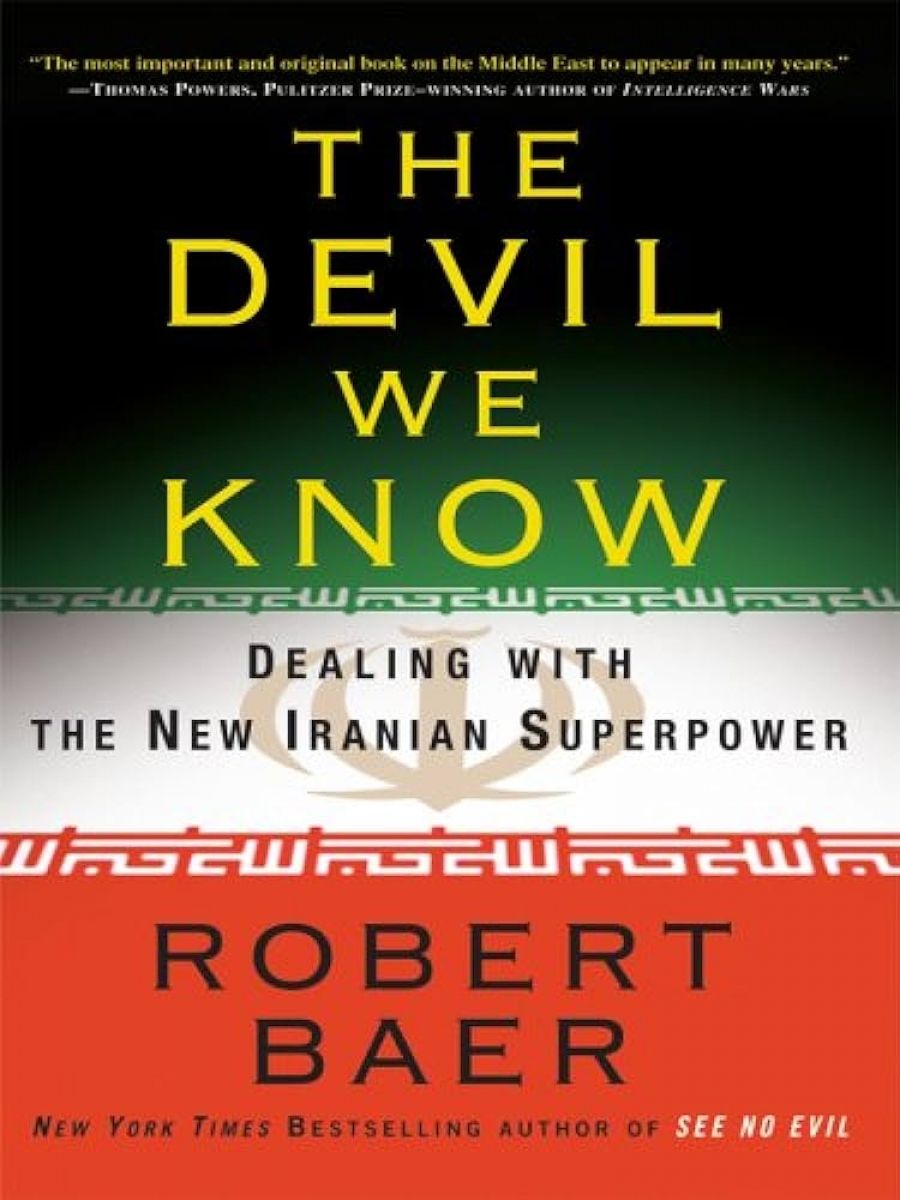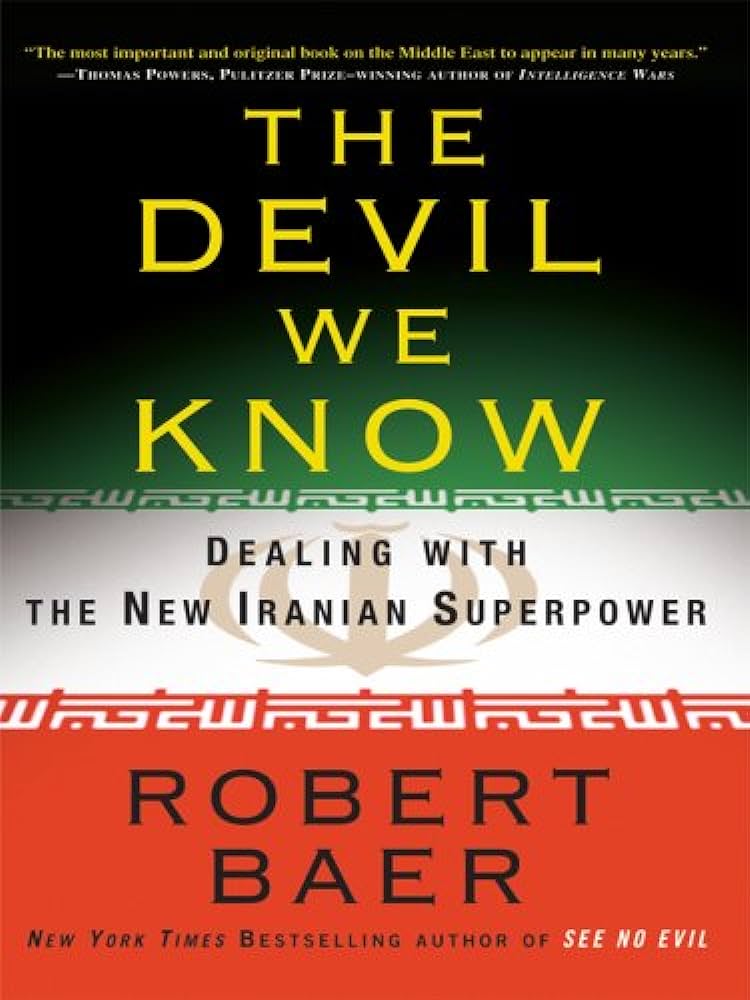
- Free Article: No
- Contents Category: Politics
- Review Article: Yes
- Article Title: Bitter pill in Iran
- Online Only: No
- Custom Highlight Text:
One of the legacies of the Bush years has been the creation in the United States of an image of Iran as a monster, a dangerous rogue state that sponsors world terror and is bent on acquiring nuclear weapons with which to attack Israel. The image is encouraged by disgruntled Iranian expatriates who promote their personal interests by peddling out-of-date ‘expertise’ to grateful think-tanks along the Washington beltway. As Robert Baer observes in The Devil We Know, Americans tend to see the turban and not the brain. His book is a timely corrective. Drawing on his years as a senior CIA operative in the Middle East, he begins it with some little known facts.
- Book 1 Title: The Devil We Know
- Book 1 Subtitle: Dealing with the new Iranian superpower
- Book 1 Biblio: Scribe, $32.95 pb, 279 pp
- Book 1 Cover Small (400 x 600):

- Book 1 Cover (800 x 1200):

Iranians may hate the United States for occupying large swathes of Arab territory, but not the American people or, by and large, their culture. Among Iranian students, Oprah is a favourite television program. Howard Conklin Baskerville, an American missionary teacher who was shot trying to break a siege in Tabriz during the 1905–11 constitutional revolution, is a revered Iranian martyr.
Iran is not a totalitarian state run by ‘Islamofascists’, and President Ahmadinejad is a figurehead no more able to take Iran to war than Joseph McCarthy was able to take America to war against communism. Iran’s real leaders are rational, pragmatic and calculating clerics, led by Ayatollah Khamenei. Part mullah, part dictator, part mediator and part police chief, Khamenei governs more like a twelfth-century pope than an American president. He is certainly no totalitarian fascist like Adolf Hitler.
Baer asserts that the Iranian leaders are not after conventional territorial gains through marching in troops or flying flags over ‘captured’ territory, least of all in Iraq following Saddam Hussein’s destruction. But they do have ambitions to exercise Iranian influence by proxy, and in this they are being singularly successful. Their first foray was into Lebanon, before the 2003 American invasion of Iraq. Hezbollah, a Shia paramilitary organisation, was inspired by Ayatollah Khomeini and created by Iranian Revolutionary Guards who infiltrated Lebanon in direct response to the Israeli invasion of that country in 1982. Hezbollah successfully fought the invasion, and is now a significant and legitimate Lebanese political force. It has seats in parliament, operates radio and television stations, and runs schools, hospitals and agricultural services for thousands of Lebanese Shi’ites.
In this context, Baer makes one of his most penetrating observations: he distinguishes between Sunni takfiris and Iranian suicide bombers. Takfiris see the world in black and white. A takfiri’s mission is to recreate the Caliphate and destroy all non-believers, a driving philosophy of blind rage against the infidel which motivated both the 9/11 and Bali bombers: destruction for destruction’s sake. Shia suicide bombers, on the other hand, are deployed as precision weapons to get political or tactical results: to prevent a repeat of past injustices, or to gain concessions. Hezbollah uses suicide bombing as a military tactic rather than a way to reach heaven. It initiated the bombings of the US embassy in Beirut in April 1983, and US Marine barracks in October 1983, to persuade Washington to stop supplying weapons to Saddam Hussein in his war against Iran. But according to Baer, it has deployed none since the end of that war in 1988.
It is thus delusional for Western advocates of the ‘war against terror’ to cram all suicide bombers into the same nihilistic mould. A few, mainly Sunni takfiris and their murderous cousins in Bali, will go for maximum terror and bloodshed. The Shia majority, however, and Iranian Shias in particular, have a much more calculating and selective philosophy. They can even be reasoned with.
After Lebanon, Iran extended its influence among Shi’ites in southern Iraq. Baer claims that, since the fall of Saddam Hussein, Iran has effectively annexed the entire south, fully one third of Iraq. In Basra today, the preferred currency is the Iranian rial, the military and police answer not to Baghdad but to Iranian-backed political parties, and Iranian proxies run the universities, hospitals and social welfare organisations. By destroying Saddam Hussein and his T72 tanks, the US also destroyed the capacity of the Baghdad government, and the Sunnis, to contest Iranian influence in the south.
Baer goes on to claim that Iranian influence is now spreading to the twenty per cent of northern Iraq inhabited by the Kurds. Overwhelmingly Sunni, the Iraqi Kurds agreed to join the US-created Iraqi government only after being promised the Iraqi presidency, a mainly ceremonial position occupied by Jalal Talabani. But since the US invasion of Iraq, Iranian Revolutionary Guards have been quietly working to extend their authority over the Kurdish Hezbollah and its leader Adham Barzani. Baer predicts that Iranian influence will eventually also spread to Kurds in south-eastern Turkey and eastern Syria.
Then there is the Gulf. Baer makes the obvious point that, with concentrated rocket attacks or the sinking of large vessels, the Iranians could easily close this waterway at the narrow Straits of Hormuz, thereby interrupting the flow of Middle Eastern oil to Western markets with catastrophic results. They could also gain influence, if not outright control, of the weak régimes along the southern coast of the Gulf. Bahrain, part of Iran for centuries until the Qajar Dynasty, and with seventy per cent of its 700,000 population Shia Muslims, would be the first sheikhdom to fall. The United Arab Emirates is also vulnerable to any Iranian moves against it. One ploy would be to overthrow the Al Makhtoum family of Dubai and have the substantial Persian population of the Emirates call for Iranian intervention.
And Saudi Arabia? Yet another virtual country, a colonial confection, argues Baer. ‘Its borders are artificial, and it is ruled by fragile tribal coalitions that will crack under Iranian pressure.’ Pressure, I recall from my posting in Tehran in the 1970s, that the Saudis then feared would come from the Shah as much as they now fear it from the Iranian clerics.
Reading Baer’s litany of weakness and fear surrounding Iran, I kept asking myself two questions. What are Iran’s motives in expanding its influence so dramatically in its Middle Eastern neighbourhood, and what, if anything, can the United States do about it? Baer answers both concisely and sensibly.
First, the Iranians want the United States to acknowledge their right to have a role in Middle Eastern affairs, a role grounded in respectful acknowledgment of the history of the Persian Empire. This includes recognition of Iran’s long-term vital interest in stabilising Iraq so that chaos does not spill over its borders, and of the influence it has in Lebanon, Syria and Kurdish territories. Second, they want a promise that the United States will neither militarily attack Iran nor meddle in its politics.
Baer then cites former Iranian president Akbar Hashemi Rafsanjani as elaborating this minimalist position. Rafsanjani says that Iran would fight any war necessary for the security of the clerical régime. But he admits quite frankly that in the longer term Iran is committed to undermining the ‘unipolar’ world in which the United States is the single hegemon. Rafsanjani also wants Iran to regain its past ‘greatness’ as a citadel of Islam, part of whose aim is to take control of Mecca and Medina, Islam’s two holy cities.
Baer says that the United States has three options, but there are really five, only one of which is realistic. The United States could try to contain Iran. This would require approximately 500,000 troops kept indefinitely on Iran’s borders to restore order in Iraq and Afghanistan and to stop Iran from spreading its influence, a hugely costly enterprise that would bankrupt America. Second, the United States could bomb Iran, the sort of thing all Israeli political parties have acknowledged as being on the table to stop Iran’s alleged nuclear weapons program. Such a campaign, either by the United States or Israel, would have disastrous repercussions, including closure of the Persian Gulf to oil traffic, and a spate of suicide bombings throughout the region by Hezbollah. Third, the United States could invade Iran. But given Iran’s mastery of guerrilla warfare, American casualties would be astronomical and politically unacceptable. Fourth, the United States could provoke a Sunni–Shia civil war – what Baer calls the Mad Max option. By arming Sunni takfiris in Lebanon to attack Hezbollah, the United States could plunge the country into a civil war in which Iran would be compelled to support Lebanese Shia, and would lose its anti-colonial credentials as a result.
A fifth option, in my view the only practical one, would be for the United States to sit down with Iran, treat it as the Middle Eastern power it has become, and see what it has to offer. This would be a bitter pill, acknowledging Iran’s predominance in the Middle East, but, says Baer, it would be infinitely better than the alternatives. Thankfully, President Obama seems to be leaning in that direction.


Comments powered by CComment